The wonders of wagyu
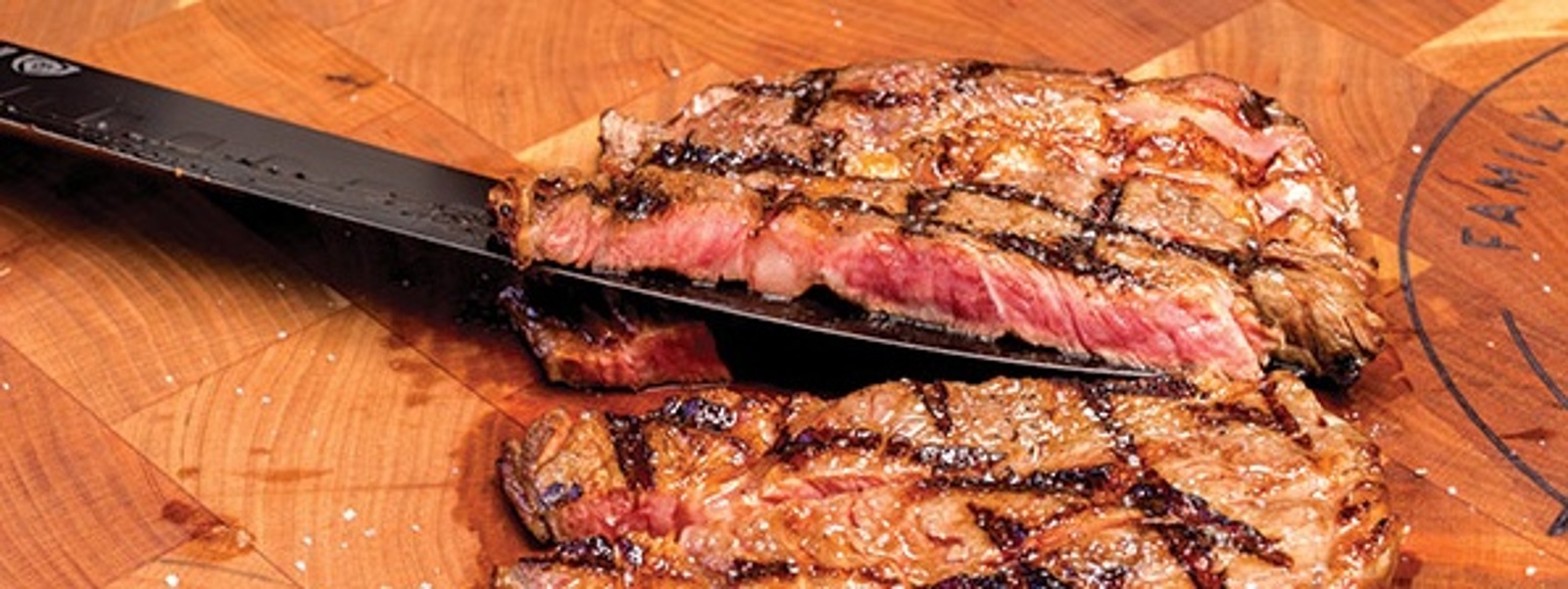
Spring 2024 California Bountiful magazine
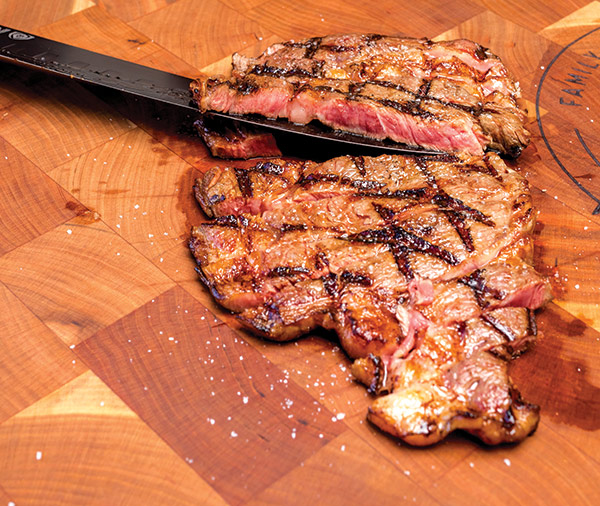
California ranch, meat company specialize in renowned beef
Story by Linda DuBois
The Meatery photos by David Poller
Masami Cattle Ranch photos by Frank Rebelo
Sometimes Nick Fiorentino wants a steak that’s “rich and exquisite,” but oftentimes he prefers one that’s “more beefy and less heavy.”
So, he just picks the type of Wagyu beef that suits his craving.
As the co-owner of the retail meat company The Meatery in San Diego, he has convenient access to a few options.
In their storefront and on their website, he and his nephew and business partner, Tony Morales, sell a variety of meats such as pork, Angus beef and seafood, along with spices, rubs and sauces. But their specialty is Wagyu, the flavorful, tender beef from cattle raised for thousands of years in Japan.
The Meatery carries Japanese A5 Wagyu—the highest grade available—including certified Kobe beef, considered the world’s most delectable meat for its intense marbling, buttery flavor and melt-in-your-mouth texture. But 100% Japanese Wagyu is also the world’s most expensive meat because of the labor- and time-intensive way the cattle are raised and their limited supply outside of Japan.
That’s partly why many customers opt for The Meatery’s American Wagyu, which comes from Wagyu-Angus cattle crosses and can be a fraction of the cost.
Most of The Meatery’s American Wagyu comes from the 7,000-acre Masami Cattle Ranch in Corning, owned and managed by Japanese ranchers. Masami’s meat is “just phenomenal,” Fiorentino says.
“One night, I lined up a Kobe filet, an Australian Wagyu filet and a Masami filet, and I really enjoyed the American Wagyu filet the most—and it’s sitting next to a $200-something piece of Kobe tenderloin, which is widely regarded as the most prized meat in the world,” Fiorentino says.
“Japanese A5 Wagyu is for when you’re looking for something very heavy and very, very rich,” suitable as an appetizer, he says. American Wagyu’s appeal is that it maintains much of the flavorful marbling from the Wagyu genes, but the Angus genes make it mild enough to eat as a main course and give it a more familiar flavor profile that American steak lovers have grown to love, he adds.
“I can only eat 4 or 5 ounces of Japanese Wagyu and I tap out, but I can have a whole Masami steak and enjoy it, and not feel heavy and weighed down.”
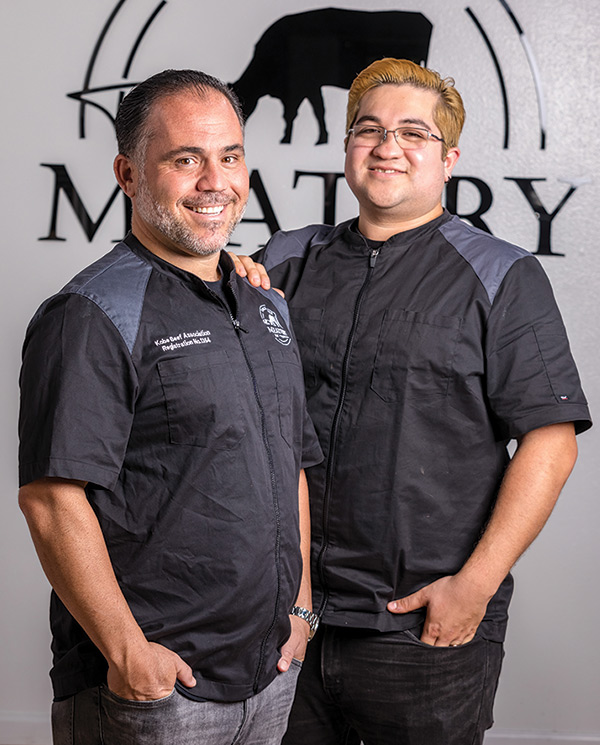
Serendipitous business
With a full-time career in internet marketing, Fiorentino started The Meatery during the pandemic lockdown in 2020 to provide restaurant-quality meat to people when going out to dinner wasn’t an option. But he stumbled upon the idea serendipitously.
Influenced by his family, who owned slaughterhouses, Fiorentino and a friend had decided to launch a side business making internationally themed spice blends for steak.
“We had all these country-specific spices: Italy, Japan, Mexico, Brazil. I bought a piece of Wagyu to try our Japan flavor on. It was my first Wagyu experience—and I immediately fell in love,” Fiorentino says. Friends he shared the meat with were equally enthusiastic.
Seeing its business potential, he quickly put together a website, advertised online and started selling and shipping Wagyu directly to home cooks.
One of Fiorentino’s first hires was Morales, who started in the warehouse and now runs operations. Joining them on the staff are a few warehouse and sales employees and a videographer for social media marketing.
Even after opening the storefront, internet sales still account for 75% of the company’s business, Fiorentino says.
Often visitors to the website also consult the recipes, informational blogs and cooking-demonstration videos created for those unfamiliar with Wagyu. They can also opt for live video chats with the storefront staff.
Fiorentino says his favorite aspect of running the meat company has been regularly interacting with customers and getting to know the ranchers who provide the meat, including those at Masami Cattle Ranch.
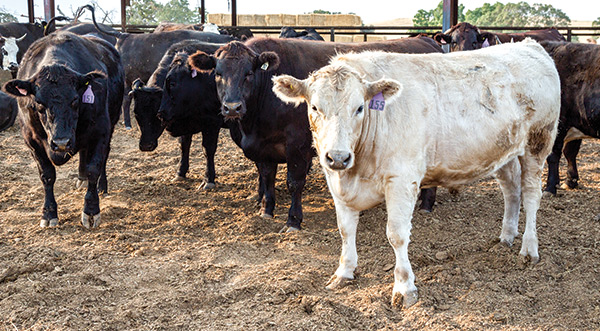
Room to roam
The Corning ranch was founded in 1988 by Japanese rancher Masami Ishida. Wary of the stiff competition and high cost of 100% Wagyu in Japan, he had created a herd in his home country with Wagyu-Angus cattle he imported from Australia (most Wagyu cattle outside of Japan are crosses with other breeds, typically Angus). After Japanese consumers responded favorably to his meat, Ishida was confident that Americans would love it too. He has since passed away, but the ranch is still owned by his family.
Seiya Uezu, a native of Okinawa, has managed the ranch for 10 years. He doesn’t come from a farming family but developed a fondness for cattle and a passion for working with them as a boy when he helped care for bulls used in Okinawan-style bullfights (a nonviolent sport in which two bulls lock horns and attempt to force each other to give up ground; whichever one disengages first loses).
Under his care are about 2,500 cattle, including about 1,000 breeding females. Calves are born and live their entire lives at the ranch.

“Cattle can get stressed from being moved from one place to another,” Uezu says.
Masami Cattle Ranch gives the animals as much freedom to roam on grassland as possible so they can eat grass when they want to and get a little exercise, which helps keep them happier, Uezu says.
During their first eight to 10 months, calves eat only grass. Then a small portion of grain is introduced. The amount gradually increases as they age until they’re eating 80% grain to 20% grass at their finishing age of 27 to 30 months.
The feed recipe—with slight modifications to accommodate locally sourced ingredients—is one the company has used in Japan on Wagyu-Angus herds and has proven to produce the best flavor, Uezu says. The ranch buys the ingredients—such as corn, barley, alfalfa and wheat mill run (a mix of bran, germ and flour)—from a local feed company and mixes it at the ranch each day, he adds.
The mix is dumped by machine into feeding troughs, but the staff feeds the cattle rice straw by hand separately to make sure they get enough fiber to balance the heaviness of the grain, Uezu says. Handfeeding also helps ensure the ranchers closely monitor the cattle, he adds.
The meat packing is done at the company’s facility in Klamath Falls, Oregon, built in 1992. Nearby, the company has also added a second, 4,000-acre cattle ranch.
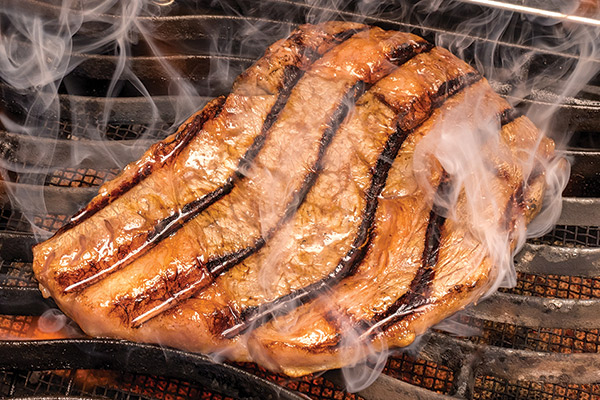
American Wagyu’s future
Masami’s meat is sold wholesale to retail outlets, butcher shops and restaurants such as SingleThread in Healdsburg, NIKU X in Los Angeles and Quince in San Francisco.
Uezu agrees with Fiorentino that American Wagyu is perfect for a steak meal, and once people try it, its popularity should take off.
“People think Japanese Wagyu is a very fancy meat. And, yeah, when you take a bite, it melts in your mouth, but you can’t eat a whole steak. That’s just too much fat. So, if people want to enjoy like 1 pound of steak, then the Japanese Wagyu-Angus cross is the best,” Uezu says.
However, they both caution that in the U.S., there is so much variation in the quality of meat advertised as Wagyu that people need to be savvy when making purchases. For example, a restaurant’s “Wagyu burger” sold in the same price range as other burgers may contain only a small fraction of actual Wagyu. “Consumers need to find a good source,” Uezu says.
Fiorentino adds that as people become more educated about the different types of Wagyu and that it’s higher in healthful monounsaturated fat and lower in saturated fat than other beef, they’ll be more likely to try it.
“I think the entire Wagyu market is only just beginning,” Fiorentino says, “and I really think that it’s here to stay.”
What makes Wagyu special?
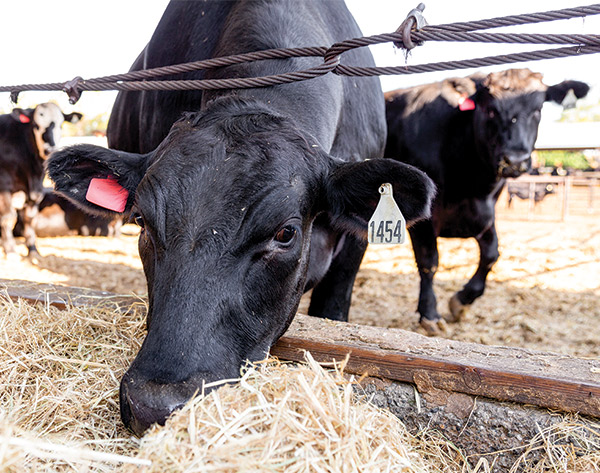
“Just what is Wagyu?” is a question Nick Fiorentino, the owner of The Meatery retail meat company in San Diego, gets from steak lovers who are unfamiliar with this delicious but pricey beef.
He enjoys answering their questions and helping them learn about the history and benefits of this meat derived from native Japanese cattle.
The term “Wagyu” literally means “Japanese cow,” Fiorentino says. Its famous succulent marbling is the result of a centuries-old practice of selective breeding and the labor-intensive and time-consuming process of raising the cattle, he says.
According to the American Wagyu Association, Wagyu genetics date back about 35,000 years. They were originally draft animals used in agriculture, selected for their physical endurance. This favored animals with more intra-muscular fat cells that provided them with a readily available energy source.
Four breeds are considered Wagyu beef, each originating from different regions in Japan: Japanese Black, Japanese Brown, Japanese Shorthorn and Japanese Polled, with Japanese Black being the most famous and sought-after.
During the 1990s, there were several importations of Wagyu males and females into the U.S. and Wagyu genetics around the world today outside of Japan can be traced to these imports, according to the association. Later in the 1990s, the Japanese government banned further exports of Wagyu genetics (semen, embryos and live cattle) and declared Wagyu a national living treasure.
The limited supply helps drive up the cost, but Wagyu’s grading also affects its price. Marbling, color and texture all affect grading, with a system ranging from A1 to the highest grade, A5. Depending on the grade, prices can range from under $35 to more than $200 for one 10- to 12-ounce steak.

